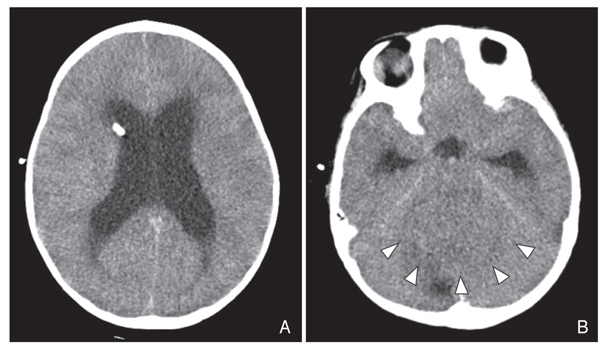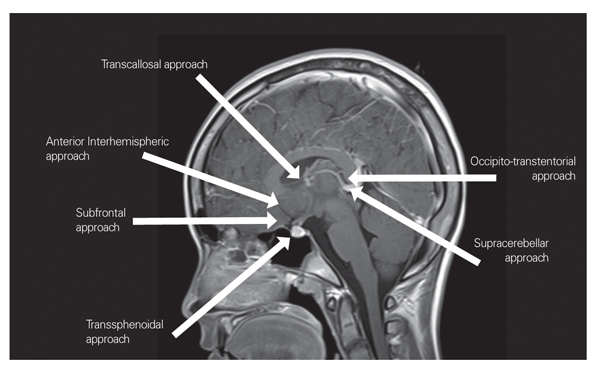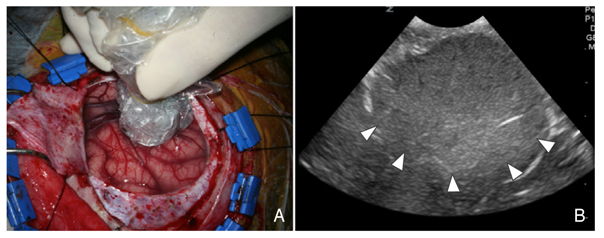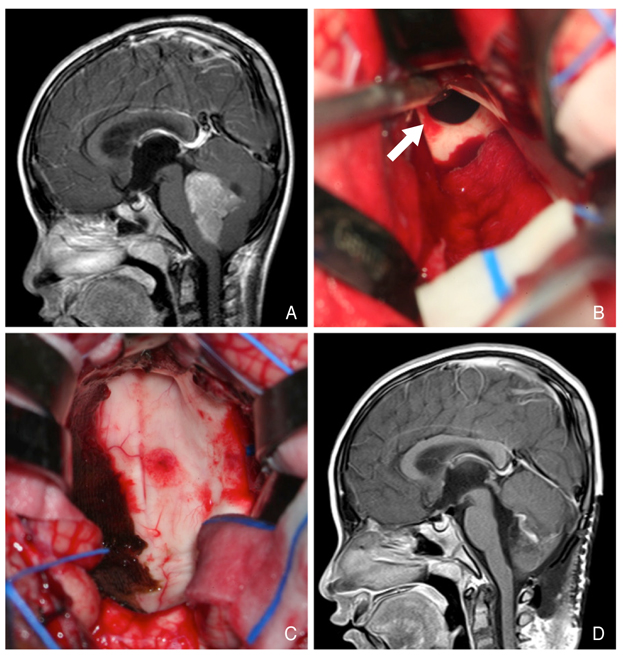J Korean Med Assoc.
2012 May;55(5):438-446. 10.5124/jkma.2012.55.5.438.
Surgical treatment of pediatric brain tumors
- Affiliations
-
- 1Division of Pediatric Neurosurgery, Seoul National University Children's Hospital, Seoul, Korea. nsthomas@snu.ac.kr
- 2Adolescent Cancer Center, Seoul National University Cancer Hospital, Seoul, Korea.
- KMID: 2064800
- DOI: http://doi.org/10.5124/jkma.2012.55.5.438
Abstract
- Brain tumors are the second most common form of cancer in the pediatric age group. Surgical treatment is the mainstay of therapy for many brain tumors and is usually the first treatment given to children with brain tumors. Pediatric brain tumors differ from those of adults in many aspects: histological diagnosis, immaturity of the pediatric central nervous system, and the vulnerability of children to blood loss during the operation. The completeness of surgery is strongly associated with the prognosis of afflicted children, whereas surgical morbidities can be life-time deficits and handicaps for the children. Therefore, practicing pediatric neurosurgeons should combine a thorough knowledge on neuroanatomy and pathophysiology with state-of-the-art surgical skills and experience to obtain the best results. They should also take time for reflecting on the difficulties encountered and complications arising during operations.
Keyword
MeSH Terms
Figure
Reference
-
1. Kim HS, Gong SH, Kim SY, Shin HJ, Kim JY, Ahn DH. Analysis on the childhood cancers based on cancer registry program in Korea in the recent 5 years. Korean J Pediatr Hematol Oncol. 2003. 10:170–176.2. Phi JH, Wang KC, Park SH, Kim IH, Kim IO, Park KD, Ahn HS, Lee JY, Son YJ, Kim SK. Pediatric infratentorial ependymoma: prognostic significance of anaplastic histology. J Neurooncol. 2012. 106:619–626.
Article3. Giangaspero F, Eberhart CG, Haapasalo H, Pietsch T, Wiestler OD, Ellison DW. Louis DN, Ohgaki H, Wiestler OD, Cavenee WK, editors. Medulloblastoma. WHO classification of tumours of the central nervous system. 2007. 4th ed. Lyon: International Agency for Research on Cancer;132–140.4. Phi JH, Chung CK. Perioperative use of anticonvulsants in neurosurgery. J Korean Epilepsy Soc. 2003. 7:37–40.5. Phi JH, Chung CK. Treatment of epilepsy associated with brain tumors. J Korean Med Assoc. 2010. 53:603–612.
Article6. Bird S. Failure to diagnose: brain tumour. Aust Fam Physician. 2010. 39:335–337.7. Chung JK, Kim YK, Kim SK, Lee YJ, Paek S, Yeo JS, Jeong JM, Lee DS, Jung HW, Lee MC. Usefulness of 11C-methionine PET in the evaluation of brain lesions that are hypo- or isometabolic on 18F-FDG PET. Eur J Nucl Med Mol Imaging. 2002. 29:176–182.
Article8. Phi JH, Paeng JC, Lee HS, Wang KC, Cho BK, Lee JY, Park SH, Lee J, Lee DS, Kim SK. Evaluation of focal cortical dysplasia and mixed neuronal and glial tumors in pediatric epilepsy patients using 18F-FDG and 11C-methionine pet. J Nucl Med. 2010. 51:728–734.
Article9. The Korean Society for Pediatric Neuro-Oncology [Internet]. c2009. cited 2012 Apr 5. Daegu: The Korean Society for Pediatric Neuro-Oncology;Available from: http://www.kspno.or.kr.10. Mussi AC, Rhoton AL Jr. Telovelar approach to the fourth ventricle: microsurgical anatomy. J Neurosurg. 2000. 92:812–823.
Article11. Dellaretti M, Touzet G, Reyns N, Dubois F, Gusmao S, Pereira JL, Blond S. Correlation among magnetic resonance imaging findings, prognostic factors for survival, and histological diagnosis of intrinsic brainstem lesions in children. J Neurosurg Pediatr. 2011. 8:539–543.
Article12. Van Poppel K, Broniscer A, Patay Z, Morris EB. Alexander disease: an important mimicker of focal brainstem glioma. Peditr Blood Cancer. 2009. 53:1355–1356.
Article13. Zaheer SN, Wood M. Experiences with the telovelar approach to fourth ventricular tumors in children. Pediatr Neurosurg. 2010. 46:340–343.
Article14. Sutton LN. Winn HR, Kliot M, Lunsford LD, Friedman WA, Sonntag VK, Vollmer DG, Marshall LF, Grady MS, editors. Intracranial ependymoma. Youmans neurological surgery. 2004. 5th ed. Philadelphia: Saunders;3623–3637.15. Willems PW, van der Sprenkel JW, Tulleken CA, Viergever MA, Taphoorn MJ. Neuronavigation and surgery of intracerebral tumours. J Neurol. 2006. 253:1123–1136.
Article16. Borkar SA, Sinha S, Sharma BS. Remote site extradural haematoma. J Clin Neurosci. 2009. 16:1097–1098.
Article17. Mohindra S, Mukherjee KK, Gupta R, Chhabra R, Gupta SK, Khosla VK. Decompressive surgery for acute subdural haematoma leading to contralateral extradural haematoma: a report of two cases and review of literature. Br J Neurosurg. 2005. 19:490–494.
Article18. Lee M, Wisoff JH, Abbott R, Freed D, Epstein FJ. Management of hydrocephalus in children with medulloblastoma: prognostic factors for shunting. Pediatr Neurosurg. 1994. 20:240–247.
Article19. Gudrunardottir T, Sehested A, Juhler M, Schmiegelow K. Cerebellar mutism: review of the literature. Childs Nerv Syst. 2011. 27:355–363.20. Tsutsumi S, Yasumoto Y, Ito M. Central pontine and extrapontine myelinolysis in an infant associated with the treatment of craniopharyngioma: case report. Neurol Med Chir (Tokyo). 2008. 48:351–354.
Article21. Rieken S, Mohr A, Habermehl D, Welzel T, Lindel K, Witt O, Kulozik AE, Wick W, Debus J, Combs SE. Outcome and prognostic factors of radiation therapy for medulloblastoma. Int J Radiat Oncol Biol Phys. 2011. 81:e7–e13.
Article
- Full Text Links
- Actions
-
Cited
- CITED
-
- Close
- Share
- Similar articles
-
- The role of chemotherapy in the treatment of pediatric brain tumors
- Advanced Magnetic Resonance Imaging for Pediatric Brain Tumors: Current Imaging Techniques and Interpretation Algorithms
- Stereotactic radiosurgery for brain metastases
- Radiation therapy for pediatric brain tumors
- Advanced MRI for Pediatric Brain Tumors with Emphasis on Clinical Benefits





